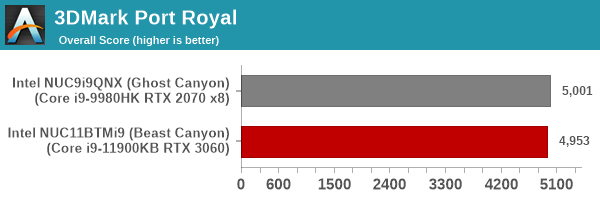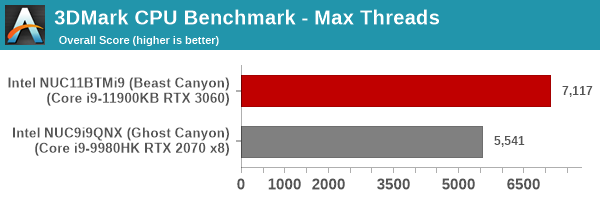Intel Beast Canyon NUC Review: Desktop Tiger Lake Debuts in SFF Gaming Powerhouse
by Ganesh T S on July 29, 2021 9:00 AM EST- Posted in
- Systems
- Intel
- NUC
- Tiger Lake
- NUC11
- Beast Canyon
UL Benchmarks - PCMark and 3DMark
This section deals with a couple of UL Futuremark benchmarks - PCMark 10 and 3DMark. While PCMark evaluates the system as a whole, 3DMark focuses on the graphics capabilities with emphasis on gaming workloads.
PCMark 10
UL's PCMark 10 evaluates computing systems for various usage scenarios (generic / essential tasks such as web browsing and starting up applications, productivity tasks such as editing spreadsheets and documents, gaming, and digital content creation). We benchmarked select PCs with the PCMark 10 Extended profile and recorded the scores for various scenarios. These scores are heavily influenced by the CPU and GPU in the system, though the RAM and storage device also play a part. The power plan was set to Balanced for all the PCs while processing the PCMark 10 benchmark.





3DMark
UL's 3DMark comes with a diverse set of graphics workloads that target different Direct3D feature levels. Correspondingly, the rendering resolutions are also different. We use 3DMark 2.4.4264 to get an idea of the graphics capabilities of the system. In this section, we take a look at the performance of the Intel NUC11BTMi9 (Beast Canyon) across the different 3DMark workloads.
3DMark Ice Storm
This workload has three levels of varying complexity - the vanilla Ice Storm, Ice Storm Unlimited, and Ice Storm Extreme. It is a cross-platform benchmark (which means that the scores can be compared across different tablets and smartphones as well). All three use DirectX 11 (feature level 9) / OpenGL ES 2.0. While the Extreme renders at 1920 x 1080, the other two render at 1280 x 720. The graphs below present the various Ice Storm worloads' numbers for different systems that we have evaluated.
| UL 3DMark - Ice Storm Workloads | |||

3DMark Cloud Gate
The Cloud Gate workload is meant for notebooks and typical home PCs, and uses DirectX 11 (feature level 10) to render frames at 1280 x 720. The graph below presents the overall score for the workload across all the systems that are being compared.

3DMark Fire Strike
The Fire Strike benchmark has three workloads. The base version is meant for high-performance gaming PCs. Similar to Sky Diver, it uses DirectX 11 (feature level 11) to render frames at 1920 x 1080. The Extreme version targets 1440p gaming requirements, while the Ultra version targets 4K gaming system, and renders at 3840 x 2160. The graph below presents the overall score for the Fire Strike Extreme and Fire Strike Ultra benchmark across all the systems that are being compared.
| UL 3DMark - Fire Strike Workloads | |||

3DMark Time Spy
The Time Spy workload has two levels with different complexities. Both use DirectX 12 (feature level 11). However, the plain version targets high-performance gaming PCs with a 2560 x 1440 render resolution, while the Extreme version renders at 3840 x 2160 resolution. The graphs below present both numbers for all the systems that are being compared in this review.
| UL 3DMark - Time Spy Workloads | |||

3DMark Night Raid
The Night Raid workload is a DirectX 12 benchmark test. It is less demanding than Time Spy, and is optimized for integrated graphics. The graph below presents the overall score in this workload for different system configurations.

3DMark Port Royal
UL introduced the Port Royal ray-tracing benchmark as a DLC for 3DMark in early 2019. The scores serve as an indicator of how the system handles ray-tracing effects in real-time.

3DMark CPU Profile Benchmark
UL recently introduced a benchmark to test the multi-threaded capabilities of the CPU in a system. Since gaming workloads are often multi-threaded, it makes sense to include this testing as part of the 3DMark suite. The benchmark routine attempts to perform the simulation of birds / bird-like objects flocking together using as many advanced capabilities as offered by the processor. The workload is configured to run with different number of threads ranging from 1 to 16 (and a single entry for the maximum number of threads allowed in the system).
| UL 3DMark - CPU Profile Benchmark | |||

We present the benchmark results for the single and maximum threads case above.
In almost all workloads, the Beast Canyon outscores other systems heavily. In the case of GPU-bound workloads, the tussle between the RTX 2070 in the Ghost Canyon and the RTX 3060 in the Beast Canyon is too close to call.










84 Comments
View All Comments
dullard - Thursday, July 29, 2021 - link
Have you actually done the math on how infrequently ECC actually helps the typical user?So what if roughly once a year, I get a one bit change in my audio for a split second, or a single pixel changed on my video, or my photo needs to load twice from Facebook, etc. Most people just don't have anything that is valuable on their personal computers any more. Almost nothing most people do now on computers will care if a memory error occurs. Combine that with the very infrequent memory errors and it just isn't a problem.
Absolute worst case scenario: I have to restore one corrupted file from backup.
With servers, ECC certainly is needed. With certain financial and security applications, ECC is definitely needed. For people to repost spam on Facebook? Nope, ECC need not found.
willis936 - Thursday, July 29, 2021 - link
Once you start climbing up the bathtub curve it isn't one bit flip every year. It's dirty bits constantly written to disk. It's a real nightmare.Spunjji - Friday, July 30, 2021 - link
"constantly"Not really
willis936 - Friday, July 30, 2021 - link
Yes, it is. I just ditched a system that could no longer install an OS without error. Memory tests hung. It wasn't the modules. Dust had shorted some memory channel pins and either damaged the motherboard or CPU.There were bad blocks all over the disk. I ran fsck to get back the user's files but there is no telling if the data's any good.
Do you even know what a bathtub curve is?
mode_13h - Monday, August 2, 2021 - link
> Have you actually done the math on how infrequently ECC actually helps the typical user?If you have bad RAM, it can be a major source of system instability. I think this is the primary benefit of ECC.
I've wasted time debugging software problems, in the past, only to find out that the problem was specific to a given machine and that machine turned out to have bad RAM. Once the DIMM indicated by memtest was replaced, the bug stopped occurring.
So, for the sake of my time and sanity, I use ECC whenever possible. Even though bad RAM isn't that common, the premium for ECC is a small price to pay for the extra margin of safety.
When ECC isn't an option, I always do an initial overnight memtest run and try to use memory rated for a higher speed than what I plan to run it at.
dullard - Thursday, July 29, 2021 - link
And the more obvious retort, this is a "SFF Gaming Powerhouse", I asked why one would want ECC for it and you reply with "should be used only in game consoles or similar applications". Seems like you missed the point of the product.If there is another use case for this product that actually needs ECC, then I'm curious to know what that use case is.
willis936 - Thursday, July 29, 2021 - link
A powerful personal computer. NUCs are made to be personal computers. If they put a big CPU and GPU in it then it's going to handle workloads thrown at it. How does ECC not fit this use case?dullard - Friday, July 30, 2021 - link
SFF works best as portable gaming and home theater uses. Neither of which have any need for ECC.I'm not saying that some computers don't need ECC. It is just that desktop computers that need ECC usually aren't physical size limited, don't need to be portable, and/or don't need full size video cards. I'm just stumped as to any real use case that actually needs that particular combo. Every use case that I can think of where ECC helps (which is not really common for personal users) either doesn't need SFF or doesn't need a large video card. It sounds much more like a wish list than a real need.
Spunjji - Friday, July 30, 2021 - link
"It sounds much more like a wish list than a real need."Bingo, but some people's wish lists are backed up by some heavy post-hoc rationalization.
willis936 - Friday, July 30, 2021 - link
This thinking is painfully flawed.You don't *need* a computer of any kind. Why bother with a smartphone or a SFF desktop?